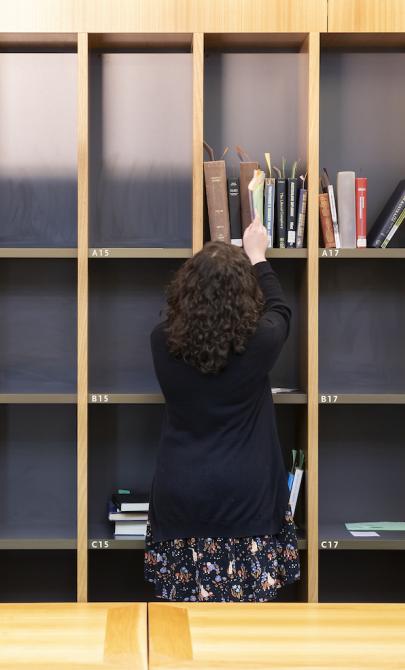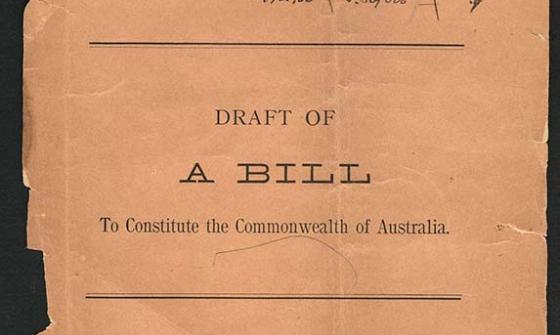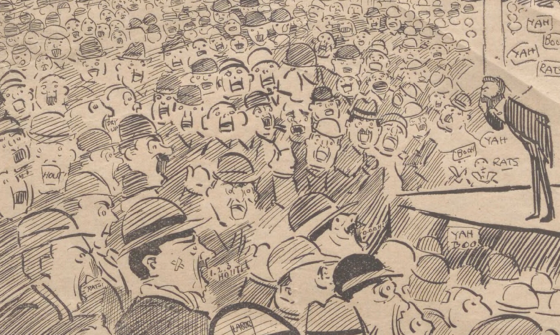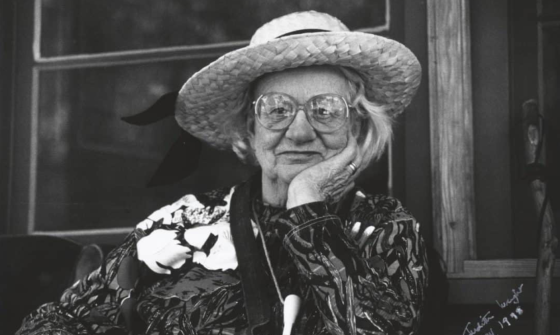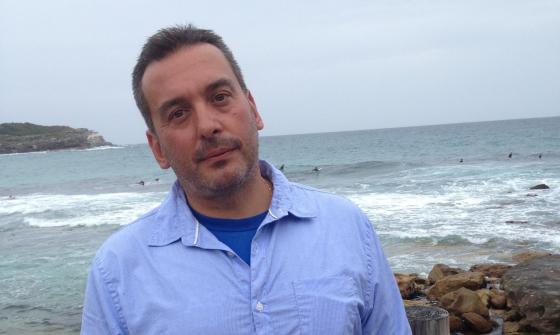Hughes Collection
Key items in the collection
Highlights from this collection demonstrate its historical significance and variety.
Papers of William Hughes
The papers of William Morris Hughes form one of the largest collections of personal papers held in the Library. They contain many types of papers: personal correspondence, electorate correspondence, official papers and reports, financial papers, subject files, diaries, notebooks, the drafts of Hughes’s books, newspaper cuttings, cutting books, speeches, broadcasts, programs, invitations, menus, photographs, books, pamphlets, election leaflets and photographs.
Despite its size, the archives really only documents the second half of Hughes’s life. Very few papers date from before 1914, by which time he had been in politics for twenty years. The early papers comprise a few letters, financial papers and newspaper cuttings, legal notebooks, the draft of The Case for Labor (1910), and papers relating to his overseas trip in 1907, the 1909 coal strike and the prosecution of the Coal Vend (1913). After Hughes became Prime Minister in 1915 the papers are more extensive and in particular there is a considerable body of material on the 1918 Imperial War Conference and War Cabinet, the 1919 Peace Conference and the 1921 Imperial Conference. Other papers relate to defence, internal security, the 1917 conscription referendum, overseas trade, shipping, industrial relations and immigration. The post-1923 papers include extensive correspondence from constituents and interest groups, election material, papers concerning Amalgamated Wireless of Australia and his ministerial portfolios, especially in 1939-41. The subject files kept in 1941-52 form one of the largest groups in the whole collection.
There are 28 illuminated addresses received by Hughes between 1900 and 1944. Among the bodies that presented them were the Sydney Wharf Labourers Union (1900), the electors of Lang (1900), the Welsh community in Melbourne (1916), his friends and supporters in West Sydney (1916), the Council of the City of Sheffield (1916), the loyal and patriotic citizens of Sydney (1921) and the New Guinea Mining Association (1939).
Letters of Hughes held in other manuscript collections
The following collections in the National Library contain letters by Hughes, while many more contain references to him:
- Papers of Sir Edmund Barton, politician and former Prime Minister
- Papers of A. Atlee Hunt, public servant
- Papers of Sir George Pearce, politician
- Papers of Sir Littleton Groom, politician
- Papers of Sir John Kirwan, politician
- Papers of J.C. Watson, politician and Prime minister
- Papers of King O’Malley, politician
- Papers of Lord Tennyson, Governor General
- Papers of Sir Thomas Bavin, lawyer and politician
- Papers of James Hume Cook, politician
- Papers of J.H. Catts, politician
- Papers of Sir Ronald Munro Ferguson, Governor General
- Papers of Richard Jebb, journalist and author
- Papers of E.L. Piesse, lawyer and public servant
- Papers of Hugh Mahon, politician
- Papers of W. Farmer Whyte, journalist and author
- Papers of Sir John Latham, politician and judge
- Papers of H.B. Higgins, politician and judge
- Papers of A.B. Piddington, lawyer
- Papers of Alfred Deakin, politician and Prime Minister
- Papers of Sir Earle Page, politician and Prime Minister
- Papers of Sir Josiah Symon, politician
- Papers of Herbert Brookes, businessman and political activist
- Papers of Sir Robert Garran, public servant
- Papers of Bessie Rischbieth, feminist
- Papers of Sir John Longstaff, artist
- Papers of Sir Keith Officer, public servant and diplomat
- Papers of Fritz Hart, composer
- Papers of Sir Keith Murdoch, journalist
- Papers of Lord Gowrie, Governor General
- Papers of E.E. Longfield Lloyd, public servant
- Papers of Andrew Fisher, politician and Prime Minister
- Papers of Sir Henry Gullett, journalist and politician
- Papers of George Robertson, publisher
- Papers of Patrick McMahon Glynn, politician
- Papers of J.A. Lyons, politician and Prime Minister
- Papers of Sir Robert Menzies, politician and Prime Minister
- Papers of Sir Timothy Coghlan, public servant
- Papers of Sir Irving Benson, Methodist clergyman
- Papers of Tom Inglis Moore, journalist and academic
- Papers of Thomas Haynes, company director
Letters of Hughes held on microfilm
A number of British manuscript collections containing letters of Hughes have been microfilmed by the Australian Joint Copying Project and are held in the Library:
- Papers of Walter Long, politician (Wiltshire County Record Office)
- Papers of Andrew Bonar Law, politician and Prime Minister (House of Lords Record Office)
- Papers of David Lloyd George, politician and Prime Minister (House of Lords Record Office)
- Papers of L.J. Maxse, editor (West Sussex Record Office)
- Papers of Douglas Sladen, author (Richmond-upon-Thames Central Library)
Papers of the biographer of Hughes
The Library holds the papers of L.F. Fitzhardinge relating to his two-volume William Morris Hughes: a political biography (1964, 1979). They contain a large body of photocopied material obtained from libraries and archives in Australia, Britain and Canada. In addition, there are letters received by Fitzhardinge, newspaper cuttings, publications, notebooks and various drafts of the biography.
A great many objects, both conventional and bizarre, came to the Library with the Hughes Papers. They included medals, a brief case, a wallet, a fountain pen, a golf club, a tea caddy, a hearing aid, a set of false teeth, and a battery-operated hearing aid called an acousticon.
We hold 3 sound recordings of W.M. Hughes made in the last 2 years of his life:
- Interview with W.M. Hughes, 25 April 1951
- OSpeeches at a luncheon in honour of W.M. Hughes at Parliament House, Sydney, 17 December 1950.
- Address by W.M. Hughes for the ABC Jubilee Celebrations, 31 December 1950
The collection includes a large number of photographs of Hughes, his second wife Mary, his daughter Helen, political colleagues, and public events he attended. Many of these were received with the Hughes Papers, while others came from newspapers, government agencies, and other sources. Most of the photographs date from the later years of Hughes’s life, though a few are from the 19th century, including one of Hughes at age four (1866) and a group photo of Llandudno Grammar School students from around 1870.
Hughes’s distinctive features and volatile temperament made him a popular subject for cartoonists. The Library holds many original cartoons and caricatures of him by artists like Stan Cross, Will Donald, John Firth, Tom Glover, Alex Gurney, Norman Lindsay, Claude Marquet, G.A. Taylor, and S.G. Wells. Of particular note are several original drawings by David Low, created during Hughes’s time in London (1916–18), including the cover design for The Billy Book: Hughes Abroad (1918).
The Library also holds an oil portrait of Hughes by Sir James Guthrie, a study for his large group portrait Statesmen of World War I (1924-30), which is displayed at the National Portrait Gallery in London.
Writings of W.M. Hughes, include:
- Australia and war today: the price of peace, 1935
- The case for labor, 1910
- Crusts and crusades: tales of bygone days, 1947
- Policies and potentates, 1950
- The price of peace, 1934
- The splendid adventure: a review of empire relations within and without the Commonwealth of Britannic nations, 1929
Biographical and historical studies, include:
- Booker, Malcolm, The great professional: a study of W.M. Hughes, 1980
- Browne, Frank C., They called him Billy: a biography of the Rt. Hon. W.M. Hughes, P.C., M.P. [1946?]
- Edwards, P.G., Prime ministers and diplomats: the making of Australian foreign policy, 1901-1949, 1983
- Fitzhardinge, L.F., That fiery particle, 1862-1914: a political biography, William Morris Hughes, 1964
- Fitzhardinge, L.F. The little digger, 1914-1952: William Morris Hughes, a political biography, 1979
- Horne, Donald, In search of Billy Hughes, 1979 [later editions with variant titles]
- Hudson, W.J., Billy Hughes in Paris: the birth of Australian diplomacy, 1978
- Hughes, Aneurin, Billy Hughes: Prime Minister and controversial founding father of the Australian Labor Party, 2005
- Jauncey, Leslie C., The story of conscription in Australia, 1935
- McMullin, Ross, The light on the hill: the Australian Labor Party, 1891-1991, 1992
- Nairn, Bede, Civilising capitalism: the Labor movement in New South Wales, 1870-1900, 1973
- Scott, Ernest, Australia during the war, 1936
- Sladen, Douglas, From boundary-rider to Prime Minister: Hughes of Australia, the man of the hour, 1916
- Souter, Gavin, Lion and kangaroo: the initiation of Australia 1901-1919, 1976
- Spartalis, P.J., The diplomatic battles of Billy Hughes, 1983
- Whyte, W. Farmer, William Morris Hughes: his life and times, 1957
About William Hughes
Early life and career
William Hughes (1862–1952) was born in London to Welsh parents. He moved to Queensland in 1884 as an assisted migrant and spent 2 years in the outback before settling in Sydney. In 1890, he opened a shop in Balmain and soon became involved in local reform movements and trade union activities. He worked as an organizer for the Amalgamated Shearers' Union and later as secretary of the Sydney Wharf Labourers Union, eventually becoming President of the Waterside Workers Federation from 1901 to 1916.
Political rise and leadership
Hughes began his political career in 1894 when he won the seat of Lang in the New South Wales Legislative Assembly. In 1901, he was elected to the first House of Representatives and became a leader of the Labor Party. He served in various government positions, including Attorney-General in Andrew Fisher's governments. During World War I, Hughes played a key role in reorganizing industries and became Prime Minister in 1915. He led the country through difficult times, including pushing for conscription, which led to a split in the Labor Party and the formation of the Nationalist Party.
Later years and legacy
Hughes continued to serve as a Member of Parliament until his death in 1952, a record unmatched in Australian history. He held various ministerial roles in the Lyons, Menzies, and Fadden governments, including Minister for Health, Minister for External Affairs, and Minister for the Navy. Despite his declining influence within the Nationalist Government in the 1920s, Hughes remained an important figure in Australian politics and finished his career as a backbencher with the Liberal Party.
Background to the collection
The Hughes papers were presented to the National Library by Dame Mary Hughes in 1953. Many of these papers were held by L.F. Fitzhardinge while writing his biography of Hughes and were only received by the Library in 1972-73. Fitzhardinge also donated his own papers on Hughes's life between 1975 and 1988.
Most of the David Low cartoons of Hughes were presented by Low in 1952.
The Hughes Papers are held in the Manuscripts Collection. They are arranged in 50 series. Use the finding-aid. There is also a card index to the correspondence in the Manuscripts Branch.
The Fitzhardinge Papers are also held in the Manuscripts Collection.
The illuminated addresses are split between the Manuscripts and Pictures Collections. Many photographs are in Series 10 of the Hughes Papers, with others in the Pictures Collection. The portrait by Sir James Guthrie, cartoons and caricatures, and most objects are in various locations within the Pictures Collection. The three sound recordings are in the Oral History Collection, and the publications are housed in the Australian Collection.
This guide was prepared using these references:
- Geoffrey Bolton, William Morris Hughes in Australian Prime Ministers, edited by Michelle Grattan, Sydney, New Holland Publishers, 2000, pp. 100-24
- L.F. Fitzhardinge, Hughes, William Morris (Billy) (1862-1952), Australian Dictionary of Biography online
- Graeme Powell, Prime Ministers as record keepers: British models and Australian practice, in Sue McKemmish and Michael Piggott, eds., The records continuum: Ian Maclean and Australian Archives first fifty years, Melbourne, Ancora Press, 1994, pp. 93-109



